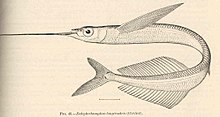Half-beak
| Half-beak | ||||||||||||
|---|---|---|---|---|---|---|---|---|---|---|---|---|

Hemiramphus far |
||||||||||||
| Systematics | ||||||||||||
|
||||||||||||
| Scientific name | ||||||||||||
| Hemiramphidae | ||||||||||||
| Gill , 1859 |
Half-beaked (Hemiramphidae) or half-beaked pike are fish from the order of the garfish-like (Beloniformes). There are over 60 species in eight genera .
The animals live in tropical and subtropical zones in the Atlantic, Indian and Pacific. Freshwater species are mainly found in South America . Half-bills are predatory and hunt small fish, freshwater species also insects on the surface of the water. With their upper fish mouth , they are adapted to this way of life.
features
Half-beaked pikes are between 5 centimeters and 55 centimeters long ( Hemiramphus brasiliensis ). The unmistakable characteristic is the greatly elongated lower jaw, which exceeds the length of the upper jaw many times over.
This feature occurs in all genera in the juvenile stage and in most genera also in the adult animals (exception e.g. Oxyporhamphus ). The related flying fish (Exocoetidae) have no elongated jaws, while both jaws are elongated in the garfish (Belonidae). The premaxillary (upper jaw bone) is pointed and triangular. The third pair of upper pharyngeal bones has grown together to form a bone plate. The nostrils are in a pit in front of the eyes. The fins do not have spine rays. The pectoral and pelvic fins are short. The dorsal and anal fins are located far back on the body. The belly-shaped pelvic fins are supported by six soft rays. In some species, the lower lobe of the caudal fin is longer than the upper. The sideline begins at the base of the pectoral fin and then goes down, near the belly line. The scales are cycloid and easily removable. The number of vertebrae is 38 to 75 (exception 18 to 25 in arrhamphus ). The parapophyses, an extension on the underside of the vertebrae, are forked.
All half-beaks live close to the water surface and their color is counter-shaded to camouflage them in this largely uncovered habitat. They are usually bluish or greenish on the back and silvery on the sides of the body and on the abdomen. The tip of the lower jaw is noticeably red or orange in most species. Spawning takes place in shallow water, the eggs stick to algae, seaweed and higher water plants. In contrast to the Zenarchopteridae , the Hemiramphidae have an external fertilization.
Systematics
A phylogenetic study from 2004 rejected the monophyly of the Hemiramphidae. The half-beak consist of three clades . The first, with the genera Euleptorhamphus , Hemiramphus and Oxyporhamphus , is the sister group of the flying fish (Exocoetidae). A second half- beak clade with the genera Arrhamphus and Hyporhamphus is the sister group of a clade from the garfish (Belonidae) and the half- beak clade Dermogenys , Hemirhamphodon and Nomorhamphus , the third half- beak clade. The latter, previously managed as the subfamily Zenarchopterinae within the half-beak, then gained family status. The family name Hyporhamphidae was proposed for the second half-beak clade.
Genera and species
- Hemiramphidae Sensu stricto
- Genus Euleptorhamphus Gill, 1859
- Euleptorhamphus velox Poey, 1868
- Euleptorhamphus viridis (van Hasselt, 1823)
- Genus Hemiramphus Cuvier, 1816
- Genus Oxyporhamphus Gill, 1864
- Oxyporhamphus micropterus (Valenciennes in Cuvier & Valenciennes, 1847)
- Genus Rhynchorhamphus Fowler, 1928
- Rhynchorhamphus arabicus Parin & Shcherbachev, 1972
- Rhynchorhamphus georgii (Valenciennes in Cuvier & Valenciennes, 1847)
- Rhynchorhamphus malabaricus Collette, 1976
- Rhynchorhamphus naga Collette, 1976
- "Hyporhamphidae"
- Genus Arrhamphus Günther, 1866
- Arrhamphus krefftii (Steindachner, 1867)
- Arrhamphus sclerolepis Günther, 1866
- Genus Chriodorus Goode & Bean, 1882
- Chriodorus atherinoides Goode & Beane, 1882
- Genus Hyporhamphus Gill, 1859
- Genus Melapedalion Fowler, 1934
- Melapedalion breve (Seale, 1910)
literature
- Joseph S. Nelson : Fishes of the World , John Wiley & Sons, 2006, ISBN 0-471-25031-7
- Bruce B. Collette: Family Hemiramphidae Gill 1859 , PDF
Individual evidence
- ↑ Half-beak on Fishbase.org (English)
- ↑ NR Lovejoy, M. Pour Iran, BB & Collette; Phylogeny and Jaw Ontogeny of Beloniform Fishes. Integrative and Comparative Biology, Volume 44, Issue 5, November 1, 2004, Pages 366–377, doi: 10.1093 / icb / 44.5.366
- ↑ a b Vivianne Sant'Anna, Bruce B. Collette, Nathan R. Lovejoy, Roberto E. Reis: A new classification of Beloniformes based on a total evidence analysis. Paper presented at the II International Symposium on Phylogeny and Classification of Neotropical Fishes .
Web links
- Half-beak on Fishbase.org (English)



